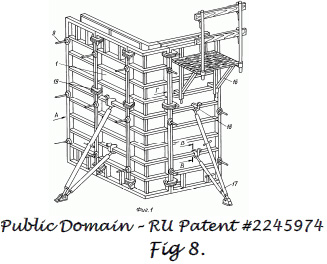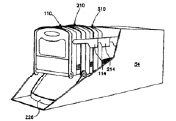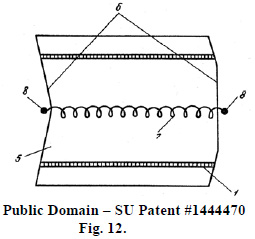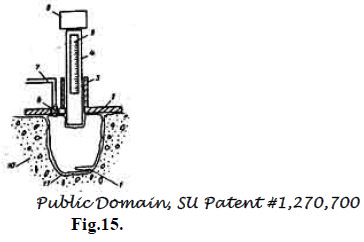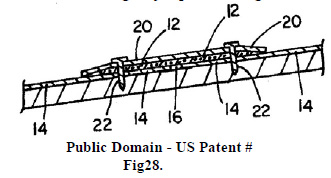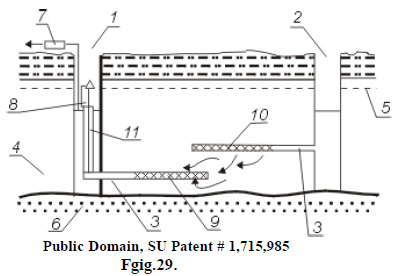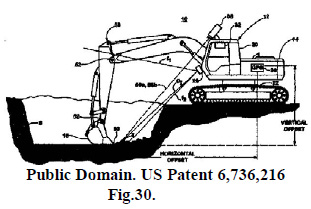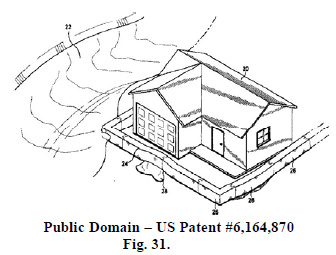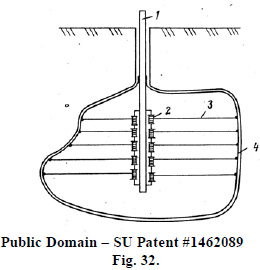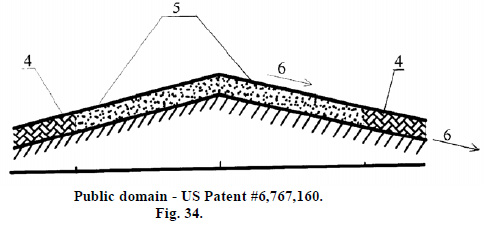Application of 40 Inventive Principles in Construction
Editor | On 10, May 2005
Abram Teplitskiy, Ph.D., Scientific Consultant
Roustem Kourmaev, President
Advanced Technologies International, Inc., Richardson, TX
tepl@sbcglobal.net
Considering construction as many-sided intersection between different brunches of science and technology, we presenting here examples of Inventive principles application in construction. Examples were taken mostly from US patents (www.uspto.gov, www.delphion.com), Russian Federation patents (www.rupto.ru), and from our inventing, consulting practice, and construction experience. We are following the traditional sequence of inventive tricks. General methodology of using the 40 inventing principles was described in basic works of G.Altshuller, and in numerical publications of specialists from former Soviet Union, USA and other countries, where readers can find detailed structure of the sub tricks, and application of using invention tricks in different branches of technology, science, business and industry. As examples of such applications we can mention two articles published already in TRIZ Journal – Ellen Domb (1) and Mann (2). Our practice, especially working experience with students, shows that effectiveness of teaching the 40 inventive principles noticeably increases when examples are easy to understand, we can say practically obvious, and are accompanied with easy to understand illustrations. We were trying to follow these two requirements in our article. We tried to describe all 40 principles by our own inventions, inventions of our clients and our students. We hope that illustrations prepared by Merle and Kelly Cunningham and Anatoliy Nelidin should make reading of this article enjoyable.
1.Segmentation.
1.1.Divide an object into independent parts:
Method of radioactive markers (tracers) is effective for investigations of soil deformations when it is significant that the marker has no mechanical contact with measuring systems. To insert a radioactive marker in the soil through wall of a borehole, especially under existing structures is not an easy problem. Device for installing markers has to move vertically, than turn, and move horizontally under existing structure. In 1974-78 years of last century we developed a family of such devices for insertion different markers and gauges to measure density, moisture content, permeability of soils, and other geotechnical characteristics of strata. We used the segmentation principle dividing an insertion rod into independent segments. To operate with these segments we connected the by pivots, and have pawls to hold the segments rigidly in chosen direction. The inserting device should be plunged in the borehole through a directional element on required depth, and the directional element should be installed on required inclination. Finally, by applying force to the system of pivotally connected segments, device could be inserted in soil under structure as shown in the Fig. 1. During moving through directional element, the segments, besides pivotal connections, should be additionally clamped with each other for providing rigidity as shown in Fig.1.b.
1.2. Make an object easy to assemble and disassemble with any degree of segmentation.
Existing decking mostly made from rigid boards. How to make round decking, or decking of any curvilinear form? It was proposed to make decking from segmented planks, with semi-pivotal elements from both vertical sides of each plank. Due for such pivoting, “neighboring†planks could be placed with any inclination according to each other. Using such decking, it could be erected concrete structures of any configuration. After strengthening of the concrete, decking could be easily disassembled. To make segments semi-connected, it should be made slits through each plank at least on two levels vertically; through these slits a flexible rubberized strips should be outstretched. The vertical edges of the decking boards should be coupled as it is shown in the picture Fig. 3.
2.Extraction (Taking Out).
Remove or separate a needless part from an object, or extract and utilize the necessary part.
Example 1: According to Darcy Law, filtration lines through parallelepiped-like filter are inclining; therefore upper triangle-like part 3 of a filter doesn’t’ contribute in filtering process is needless, and therefore could be taken out without harming the effectiveness of water purifying device (Fig.3.).
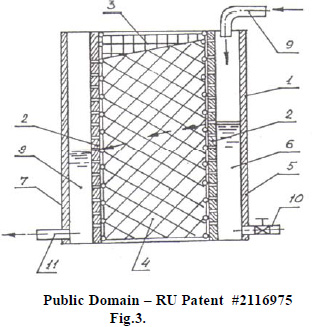
Example 2: Remotely extracting the information from water meters, and remotely transmitting it to the utility personnel, allows collecting information without access to the property (Fig 4).
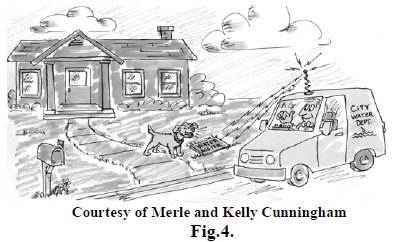
3. Local Quality:
Place each part of the object under conditions most favorable for its operation; make each part of an object fulfill a different and useful function.
Example 1: Hammer with nail puller; see, for example, US Patent # 5,002,257
Example 2. Solar and Wind Energy Generation System for a High-rise Buildings (US Patent #5,394,016).
A solar and wind energy generating system for mounting in a building comprises a wind generator system including at least an auger shaped air-engaging member. A plurality of wind generators having air-engaging vanes may also be provided. The wind generating system intercepts the flow of air currents to produce mechanical energy, which is transformed into electrical energy by an electrical generator. The air-engaging surfaces of the wind generator vanes or the auger include a plurality of surface deviations. The surface deviations are arranged in at least one predetermined pattern such as plurality of radial extending deviation sets. The solar generator includes a plurality of solar energy collectors. The wind generator may further include air engaging vanes with at least one transparent surface, and a plurality of solar energy collectors within a cavity formed in the vane, thus forming a combined solar and wind energy generator. The wind and solar generators are stored within the building when not in use, and movable to a position exterior of the building when may be vertically or horizontally mounted, on or off a pedestal, and may be surrounded by a net like structure to prevent harm to birds.
4. Asymmetry: Replace a symmetrical form with an asymmetrical form of the object.
Example 1: Trench for placing flexible pipelines, in which one wall was made with a longitude groove for placing the pipe, and prevent it from future strains of soil deformation. When one of the authors started to develop new technologies for pipe lying, analogical proposal came one of the first, but wasn’t approved by management. After twenty years were passed, it came time for such trench. Sometimes progress takes asymmetric pass (Fig 5).

Example 2. Asymmetrically shaped roofs.
5. Combining (Merging): Combine in space or in time homogeneous objects or objects destined for contiguous operations.
Example 1: Placing fiber-optic cables in sewer pipelines (Fig.6).

Example 2. Roof with Solar battery
Roof is the most open to the sun part of the building, and it is obvious the effectiveness of placement of the solar cells on the roof surface

6. Universality: Have the object perform multiple functions, eliminating the need for other objects.
Example. Universal decking.
Decking by Russian Patent RU Patent #2245974 has contour and sections of which has rectangular look, connected in various combinations by simple locks. Due to this simple structure, decking is universal and could be used to erect different concrete structures.
7. Nesting: Placing one object inside another, which in turn is placed inside a third object or one connected with another by a chain.
Example 7.1: Mailboxes, containers, trucks during transportation, ladders, etc nested inside each other (Fig.9).
Example 7.2. Telescopic crane is an example of principle nesting, or more exactly combination of principles of nesting and dynamism.
8. Counterweight (Anti-weight):
8.1. Compensate for the object’s weight by joining with another object that has lifting force
By one of hypothesis, builders of pyramids in ancient Egypt, used
8.2. Provide interaction between object and environment, which is resulting appearance of lifting force.
As illustration we can consider a jesting proposal to fill the empty channels in building panels with … smoke (This proposal was made by a civil engineering student to one of the authors). Another example shows that launching smoke in form of rings increase it’s lifting height. Results of this observation were used in design of environmentally effective smoke stacks (chimneys).
9. Principle of the Preliminary anti-action.
9.1. Drainage blocks before installing in drainage pipeline are preliminary compressed with a spring filled with water and frozen. After blocks are installed in a pipeline, ice melted, and under action of a spring blocks are connected under tension.
9.2. If pipelines are laying in swelling and shrinking soils, they could be prestressed to compensate stresses, which could appear in pipeline during exploration. Due to RU Patent #2249144 prestressing could be done by deformation of connections zones of the pipes.
10. Prior counter-action (Preliminary action).
Example 1: Prefabricated Buildings, and parts of buildings.
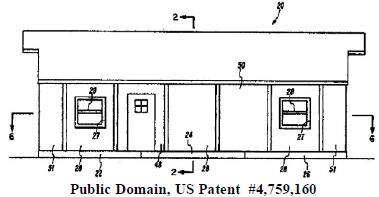
Example 2. In a Spring Washer, the necessary strain to prevent the system bolt-nut from rescrewing is provided by cutting the washer in one place, and moving the ends apart, making a piece of spring.
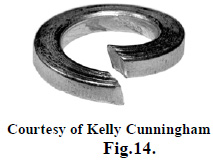
Example 3: To test the quality of soil’s compaction by simple methods, based on taking a sample of soil, weigh it and measure the volume of a pit, from which the soil was taken. Weighing is a simple operation, but measuring the volume of the pit of an unusual shape is complicated. In construction, two main methods are used: sand replacement and rubber balloon method. We proposed filling the pit with … air – there’s no need to transport it, and it can be used without cost. Using the Boyle Law and comparing the air pressure in the balloon placed in the pit and in calibrated vessel, we can calculate the volume of the pit. However, one obstacle waylaid inventors – after the balloon was filled with air, it was impossible to extract it from the pit! The idea of folding the balloon before it was placed in the pit resolved the problem.
11.Cushion in advance.
Compensate relatively low reliability of an object with countermeasures taken in advance.
Example 1. A ladder-carrying device is provided for carrying a ladder either over or under the shoulder. The ladder-carrying device includes the rigid frame and a cushion. Notice: Word cushion due to dictionary has two meanings: a pillow and make something softer. In the example below both these meanings are combined – a pillow used to softer the contact between structure and worker’s shoulder.
Example 2. Before laying a pipeline across and under the road a special casing should be installed for protection future pipeline. Example of such casing readers could find in RU Patent #?2216670.
12. Equipotentiality. Change the condition of the work so an object doesn’t need to be raised, lowered, rotated, etc.
Example. For measuring the density of soil by the attenuation of gamma rays, a collimating system was installed between two tubes. To guarantee the horizontal position of a collimator, it was made spherical and placed on the water-oil boundary inside the sphere. This system is equipotential, and the position of collimator will be strictly horizontal with any spatial movements.
13. Inversion (The other way round).
Example. Imagine that you need repair an underground pipeline, for example sewage from inside. For this purpose was developed very effective inversion technology. For better understanding how it works, imagine that you inserted one flexible pipe inside another, which have bigger diameter, and glue together ends from one side. Than you inserted this glued ends of pipes through manhole into the pipe, which you intended to repair. Now, how you can advance this “double pipe†inside repaired pipe? One simple method is obvious – pump in the circular space between inside and outside pipes air under some pressure, and you’ll witness how the inside pipe of this flexible “double†pipe will be moving inside the “host pipe, while the outside pipe will glue to the internal surface of the ‘host†pipe, which actually is under repair. This technology was created by company “Insituform Technologies, Inc., and to show that technology is effective worldwide, we illustrated this inventive trick with picture taken from Russian Patent.

14. Spheroidality, Curvilinearity: Replace linear parts or flat surfaces with curved, helical, spherical shapes.
Example 1. Cone is usually used to check up the quality of soil compaction. But cone couldn’t be used along with moving compaction machine. To solve this problem it was proposed instead of cone usage of a sphere-like wheel. During moving, vertical impacts are provided on the wheel, by value of it’s dipping into soil the quality of compaction could be evaluated.
Example 2. Curved System for evacuating people from tall buildings All floors in the tall building should be equipped with escape hatches, which are connected with specially designed “rigid-flexible†hosepipes, hanged by cables. In details structure of this equipment is described in RU Patent #2243013, and shown in the picture below.
15. Dynamism. Make characteristics of an object, or outside environment, adjusting for optimal performance or operation for different internal or external conditions.
Example 1. Moving partition, having wheels, for internal premises of a house of room. The room could be separated in different parts, having various volumes and areas depending of the taste of the people, season of year, etc. Example of such partition could be find, for example, in Russian Federation Patent #2243337.
Example 2. Inner and outer surfaces of a concrete pipe could be formed from helically wrapped interlocking plastic strips of any diameter desired.

16. Partial or overdone (excessive) actions.
Example. Nails with two heads simplify their use during frequent driving and extracting, for example for assembling and disassembling decking.
17. Moving to a new dimension. Remove problems by moving an object in a line by two-dimensional movement (along a plane). Use a multi-layer assembly of objects instead of a single layer.
Example 1. Make an anchor for retaining wall as a half of the Mobius strip to compensating the pressure on opposite sides of the strip.

Example 2. New dimension for placing electrical generator – a system comprising of rollers or the like installed along expressway lanes that vehicles passing over them would actuate them. The rollers are coupled to a network of electrical power generators so that as vehicles pass along the expressway they cause production of useful electrical power.
18. Mechanical Vibration. Set an object into oscillation, if such oscillation exists, increase its frequency, even as far as ultrasonic, use the frequency of resonance. Use ultrasonic vibrations in conjunction with an electromagnetic field.
Example: Apply vibration to a vertical tube, the top and bottom of which are covered with reticule material, and such a device would pump air from underneath to the top of the tube.
19. Periodic action. Replace a continuous action with a periodic one or an impulse. If an action is already periodic, change its frequency. Use pauses between impulses to provide additional action.
Example 1. Continuous measurements of density of geological formations by nuclear devices are provided in chamber by attenuation of gamma radiation, for example for determination layers of coal, which has density smaller that density of soil. If there is no indication of “light†soil or coal, boring tools destroyed soil, and when smaller density was indicated, sample of such “susceptive†soil is taken on the day surface for investigation. (SU Patent 982,450).
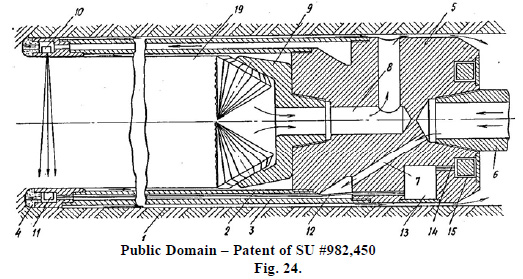
Example 2. Hydro-Accumulating Power Station.
Hydropower Plant with water accumulation section. Periodically pumping water back into the upper reservoir at night, allows increase effectiveness of the power plant because there is access to electricity at that time. In the daytime, additional water will produce additional electricity.
20. Continuity of useful action. Carry out an action without breaks – all parts of an object should constantly operate at full capacity.
Example: Conveyer system of pipe lying.
Let’s try another problem – how to make trenchwork safer. Few people wish to work in the bottom of a trench for good reasons. It is highly dangerous work, for at any time, the trench may collapse. The use of trenchboxes for protection prolongs the construction process. Let’s look at this problem through the ideal solution concept. The ideal solution in this case: the pipes are already attached to each other instead of being separate segments that are usually connected at the bottom of the trench by a worker; and this assembled pipeline, by itself, slowly descends to the bottom of the trench. We can assure that you already have the necessary information to solve this problem by yourself! Just recollect the properties of bentonite clay slurry. So, if we fill the trench with bentonite slurry, and place the pipeline on the surface of this material, we have the answer. If both ends of the pipeline are securely plugged, then the pipeline will float on the surface. Let’s slowly pump out the liquid slurry from the trench – the pipeline will slowly, strictly horizontally, descend along with the slurry level to the bottom of the trench. The solution has been found! All the assembly process could be performed at ground level, and the pipeline would place itself at the bottom of the trench. If you didn’t get an idea how to do this, look over a brief solution developed by this author at the end of 20th century. For simplicity, we can call this the Bentonite Slurry Conveyer technology, which is schematically illustrated in the drawing below.
1 – platform; 2 – protective shield; 3 – plug; 4 – catch devices of the pipes;
5 – moving part of platform 1; 6 – bentonite slurry; 7, 9 – pipes;
8 – catch devices of the pipe; 10 – pipeline trench; 11 – equipment pit.
21. Rushing through (Skipping). Perform hazardous operations at very high speed. Example: A cutter for thin wall plastic tubes prevents tube deformation during cutting by running at a very high speed (cuts before the tube has a “chance†to deform)
22. Turn harm into benefit.
Example 1: 200-kilowatt fuel cell in wastewater treatment plants uses methane gas “produced†by the plant to generate power, thereby reducing the purchase from power stations.
Example 2. Using distortion of optical lenses in photo cameras to determine the distance, for example to walls of underground cavities by the sharpest image.
23. Feedback.
Example. To eliminate the shrinkage, soil often is saturated with water, which sometimes contain special chemicals. Changes of soil properties are monitored, and results of monitoring as feedback are used to optimize watering process. Example of such feedback technologies is described in RU Patent #2224845.
24. Mediator (Intermediatery).
Use an intermediary object to transfer or carry out an action.
Example: To keep screws securely fastened to the wall, an intermediate plug (Rawlplug) with an axial hole is inserted in the initial hole.
25. Self-service. Make an object serve itself by performing auxiliary helpful functions, Use waste resources, energy, or substances.
Example 1. For providing roofs with self-healing service against leaks, underneath the roofing membrane a layer of bentonite powder is placed. In the case of leaking water seep through holes in a membrane, and watered the bentonite. Under watering the bentonite powder expands, and covered the hole. This effect could be applied for new roofs, and also for emergency repair existing roofs.
Example 2. Use ability of soil to drain water for hydraulically connecting horizontal ray-drainage lines.
26. Copying. Use simple and inexpensive copy instead of an object, which is complex, expensive, fragile or inconvenient to operate.
Example 1: Measuring sizes of big and complex buildings by their photographs rather than in natural conditions.
Example 2. Compare shadows of objects with unknown height with shadows of objects with known height for determining the height of inaccessible objects.
27. Cheap short-living objects (Inexpensive short-life in turn for expensive longevity). Replace an expensive object by a collection of inexpensive ones.
Example: Inflatable Penthouse. Such inflatable penthouse is cheap, and could be used as temporary shelter for example under unworkable weather conditions. General look and description of such penthouse could be finding, for example, in RU Patent #2220269.
28. Replacement of a mechanical system (Mechanics substitution).
Example: Measurement of depth of a trench during digging by laser-based devices.
29. Use pneumatic or hydraulic structures. Replace solid parts of an object with gas or liquid.
Example 1: Inflatable dams and Inflatable pools, inflatable plugs for pipelines, inflatable reinforcement for a dike.
Example 2. Usage of inflatable balloon to measure sizes of underground cavities (emptiness’s).
Inside balloon a stick need to be installed vertically. On this stick a set of reels with thread is put on different heights of a stick. Initials ends of a thread of each bobbin are connected with internal surface of a balloon on the level of appropriate reel. Balloon with installed equipment is dropped down in the underground emptiness to the known depth. After this the balloon should be inflated. As result of balloon expanding the outsides walls of balloon would reach the internal wall of the underground emptiness. As a result each tread will reach the wall. After this the balloon should be deflated, the device should be taken of the emptiness, and the length of each thread should be measured. The results of these measurements would be the sizes of the underground emptiness in corresponding places and depths.
30. Flexible shells and thin films. Isolate an object from its outside environment with thin film or fine membrane.
Geomembranes comprising a unitary structure fabricated by co-extrusion including a center core, a thermoplastic adhesive layer secured on one side of the center core, and a textured layer secured on the opposite side of the center core. The geomembrane is utilized in the manufacture of a liner for earthen constructions by employing the thermoplastic layer of the geomembrane to secure the geomembrane to a geosynthetic clay liner.
31. Use of porous material: Make an object porous or use additional porous elements.
Example 1. Combine monolithic and porous properties to get effective water protective and water transient structures.
Effective pavement comprises a porous pavement substrate and a monolithic compound bonded to the substrate. The porous pavement material may have a hydraulic conductivity ranging from about 0.001 to about 1.0 cm/sec and may act as a storm water storage basin. Patented structure combined constructive strength of concrete and conductivity of filters. Resulting structure has constructive strength of concrete and water conductivity of porous materials, as result, structure keeps streets out of running water and make streams of water easy manageable. For same purpose porous structures are using in Europe for roofs.
Example 2: Use porous material in soil as a sensor for soil moisture measurements. After placing in soil, a cube of porous material, for example, would be in a moisture balance with surrounding soil. Reading of two electrodes would depend of the amount of moisture absorbed by this porous cube. Therefore by these readings, using results of calibration, moisture content of soil could be determined nondestructively.
32. Color changes: Change the color of an object or its surroundings; change the degree of transparency of an object or its surroundings, etc.
Example 1: Visible fluorescent dyes make water flow patterns easy to see and track the movement in lakes, reservoirs, sewage plants, etc.
Example 2: Thermo-sensitive material changes color while temperature is changing and could be used for monitoring conditions of sensitive to temperature structures or processes.
Example 3. Alongside a gas pipeline, alfalfa should be planted. In proximity of the slightest quantity of gas leaking from a gas pipeline, alfalfa changes color. Pictures of a pipeline strip taken from a helicopter indicate where the gas is leaking.
33. Homogeneity. Make objects interact with a primary object having the same properties or ones close to its behavior.
Example: Free surface of water is homogeneously flat. In ancient Egypt, this concept was used to level the bases of Pyramids.
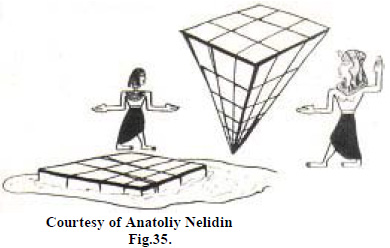
34. Discarding and recovering – Regenerating materials and parts after they has completed its function or become useless.
Example 1. In construction, regeneration means reusing materials, restoration of initial state of structures, etc. One of such examples is placing soil, which was taken from open pit to get the ore, back in place to restore the environmental equilibrium. Description of such recovering technology could be finding, for example in RU Patent #2029017.
Example 2. Reusing transparent plastic bottles, after cutting its necks, by installing them as chain in each other; from such cylinders square blocks are forming for construction purposes. According to Russian Federation Patent #2243649, such used bottles could be used for erecting greenhouses and other such structures.

35. Transformation of physical and chemical states of an object. Change the state of an object.
Example. For preparing filter blocks, assorted material was placed in a cylindrical form and frozen; than blocks was placed in the underground-perforated pipeline, … and defrosted, forming the drainage.

36. Phase transition. Use effects, which are relieved during phase transition.
Example: Use change of magnetic properties of material with heat from sunlight (Curie effect).
Alexander Presnyakov proposed a “perpetual-like†generator with stator made from metal with “magnetic-not magnetic†phase transformation; this stator rotates after heating to the Curie point, due to interaction with outside permanent magnet.
37. Thermal expansion. Use expansion or contraction of material through heat. Use and combine various materials with different coefficients of heat expansion.
Example: Nobel Prize was rewarded for the invention of a controller for lighthouses by using the thermal dilatation. Thermal dilatation also is used in controllers for temperature in greenhouses.
38. Use strong oxidizers. Replace normal air with enriched air. Use ionized oxygen.
Example: Purifying drinking water with ozone.
39. Inert environment (atmosphere). Alter the environment to an inert version. Carry out the process in vacuum.
Example: Welding in an atmosphere of inert gases – argon, for example.
40. Composite materials. Replace a homogeneous material with a combination of materials.
Example Use magnetic tape along the top of an underground pipe as an indicator for detecting the position of the pipe, or producing polymer pipes from a composite material – a mixture of polymer powder and iron filings (See, for example, US Patent 5051034 – “Magnetically detectable plastic pipeâ€).
Reference:
1. Darrel Mann and Ellen Domb, 40 Inventive (Business) Principles With Examples, TRIZ Journal
2. Darrel Mann and al., 40 Inventive (Architecture) Principles With Examples, TRIZ Journal
3. Abram Teplitskiy, Joy of Inventing for Everyone, www.3Mpub.com/teplitskiy
Copyright 2005. Abram Teplitskiy. tepl@sbcglobal.net, (972) 385-9994. All rights reserved.
About the Author: Dr. Abram Teplitskiy was born in Kursk, Russian Federation in 1946. He is a graduate of the prestigious Kharkov State University in the Ukraine where he double-majored in Applied Physics and Environmental and Materials Testing. After graduation, Abram worked in various scientific organizations. During his tenure, he conducted his own original research, and as a result, made over 100 inventions and solved problems in a diverse range of fields: from measuring the density of soils on the Moon and on the bottom of the ocean using nuclear methods, formulating technology to lay pipeline without the presence of people in the trench, to modeling nuclear processes using soap bubbles, and even … designing combs for eyelashes. The findings of his research were published in more than 80 articles in international and national journals and reported at international and national conferences throughout the USA and Europe. Following this extensive research and inventing experience, Abram Teplitskiy earned a Ph.D. in Applied Physics.
Another lifelong passion of Dr. Abram Teplitskiy is educating students in the art of inventing. To achieve this goal, he wrote and published six books, founded a special class for high school students and designed a Ukrainian national TV show for future inventors. He is proud that one of the youngsters involved was among the youngest inventors of Europe – a 12-year old boy who invented a demonstration model of a molecule.
After relocating to the United States with his family, Dr. Teplitskiy gained additional experience working with high school students. He taught Creativity Classes in a local recreation center, participated as a coach in the International Educational Internet Contest with a website “Become an Inventor,†consulted for corporate and individual inventors, and wrote articles about inventing for local newspapers. Finally, he resumed his activities in his previous field and made more inventions himself, taught students to solve problems, and subsequently began writing books in English as well as bilingual ones. This text is his first in English, and in the near future, Dr. Teplitskiy hopes to publish additional books for students.
Dr. Teplitskiy is married to a wonderful and supportive lady named Faina. Together they have two children – a daughter, Jane, who will graduate December 2004, and a son, Mikhail, who is currently a sophomore and hopes to pursue a career in math and science.
Dr. Abram Teplitskiy will be pleased to consult with readers of his book, especially students, and welcomes questions regarding both inventing and creativity.




